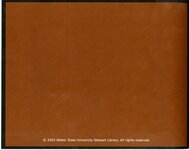| Title |
2003-1 Inside the Hoover Dam Scrapbooks |
| Creator |
Weber State Univesity |
| Contributors |
Utah Construction Company/Utah International |
| Description |
The WSU Stewart Library Annual UC-UI Symposium took place from 2001-2007. The collection consists of memorabilia from the symposium including a yearly keepsake, posters, and presentations through panel discussions or individual lectures. |
| Subject |
Hoover Dam (Ariz. and Nev.); Ogden (Utah); Utah Construction Company |
| Digital Publisher |
Stewart Library, Weber State University, Ogden, Utah, USA |
| Date Original |
2003 |
| Date |
2003 |
| Date Digital |
2008 |
| Temporal Coverage |
2001; 2002; 2003; 2004; 2005; 2006; 2007 |
| Item Size |
8 inch x 10 inch |
| Medium |
booklets |
| Item Description |
13 page booklet with text and black and white photos |
| Type |
Text; Image/StillImage |
| Conversion Specifications |
Archived TIFF images were scanned with an Epson Expression 10000XL scanner. Digital images were reformatted in Photoshop. JPG and PDF files were then created for general use. |
| Master Quality |
400 PPI |
| Language |
eng |
| Relation |
https://archivesspace.weber.edu/repositories/3/resources/212 |
| Rights |
Materials may be used for non-profit and educational purposes; please credit Special Collections Department, Stewart Library, Weber State University. |
| Source |
TC557.5.H6W42 2003 Special Collections, Stewart Library, Weber State University |
| Format |
application/pdf |
| ARK |
ark:/87278/s6a9qa2z |
| Setname |
wsu_ucui_sym |
| ID |
97629 |
| Reference URL |
https://digital.weber.edu/ark:/87278/s6a9qa2z |
| Title |
2003_024_page40and41 |
| Creator |
Stewart Library, Weber State University |
| Image Captions |
Although Frank Crowe once told a reporter that building the Hoover Dam was a job for machines the delicate tasks were performed by humans. The so-called "powder monkeys" (above) prepared dynamite cartridges and blasting caps at a distance from other crews, then brought the hazardous cargo to the diversion tunnels in time for each day's firings. Drilling preceded most essential tasks at the dam site. The drillers forced their white-hot steel bits into the canyon's stone to open holes for blasting and to set the rings that moored bridges, supplies, and equipment. |
| Description |
The WSU Stewart Library Annual UC-UI Symposium took place from 2001-2007. The collection consists of memorabilia from the symposium including a yearly keepsake, posters, and presentations through panel discussions or individual lectures. |
| Subject |
Hoover Dam, Ogden-Utah, Utah Construction Company |
| Digital Publisher |
Stewart Library, Weber State University |
| Date Original |
2003 |
| Date |
2003 |
| Date Digital |
2008 |
| Item Description |
13 page booklet with text and black and white photos |
| Type |
Text; Image/StillImage |
| Conversion Specifications |
Archived TIFF images were scanned at 400 dpi with an Epson Expression 10000XL scanner. Digital images were reformatted in Photoshop. JPG and PDF files were then created for general use. |
| Language |
eng |
| Rights |
Materials may be used for non-profit and educational purposes; please credit Special Collections Department, Stewart Library, Weber State University. |
| Source |
TC557.5.H6W42 2003 Special Collections, Stewart Library, Weber State University |
| Format |
application/pdf |
| Setname |
wsu_ucui_sym |
| ID |
97717 |
| Reference URL |
https://digital.weber.edu/ark:/87278/s6a9qa2z/97717 |


















































